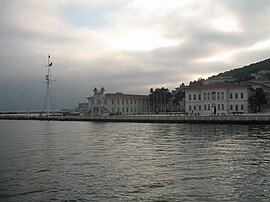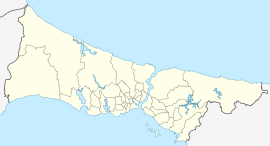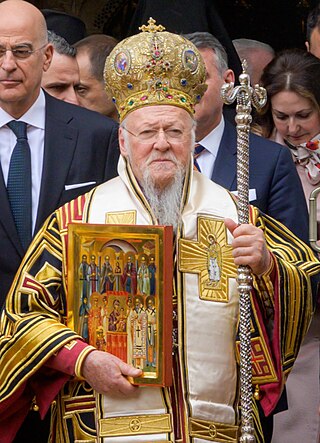
Bartholomew is the 270th Archbishop of Constantinople, since 2 November 1991. In accordance with his title, he is regarded as the primus inter pares in the Eastern Orthodox Church, and as a spiritual leader of the Eastern Orthodox Christians worldwide.

The Ecumenical Patriarchate of Constantinople is one of the fifteen to seventeen autocephalous churches that together compose the Eastern Orthodox Church. It is headed by the Ecumenical Patriarch of Constantinople.

The Princes' Islands, officially just Adalar ; alternatively the Princes' Archipelago; is an archipelago off the coast of Istanbul, Turkey, in the Sea of Marmara. The islands constitute the municipality and district of Adalar within Istanbul Province. With a total land area of 11 km2 (4.2 sq mi), it is the fifth smallest district in Istanbul, and with a permanent population of 16,690 (2022), it is by far the least populous district in Istanbul.

Philotheos Bryennios was a Greek Orthodox metropolitan of Nicomedia, and the discoverer in 1873 of an important manuscript with copies of early Church documents.

Burgazada, or Burgaz Adası, is the third largest of the Princes' Islands in the Sea of Marmara, near Istanbul, Turkey. It is officially a neighbourhood in the municipality and district of Adalar, Istanbul Province, Turkey. Its population is 1,655 (2022). In the past, it was called Antigoni after Antigonus I Monophthalmus, the father of Demetrius I of Macedon, one of the Diadochi (Successors) of Alexander the Great, who built a fort here. The name Burgas is thought to be derived from Pyrgos.

Büyükada, meaning "Big Island" in Turkish, is the largest of the Princes' Islands in the Sea of Marmara, near Istanbul, with an area of about 2 square miles. It is made up of the Maden and Nizam neighbourhoods in the Adalar (Islands) district of Istanbul Province, Turkey.
Halki or Chalki can refer to several different things:
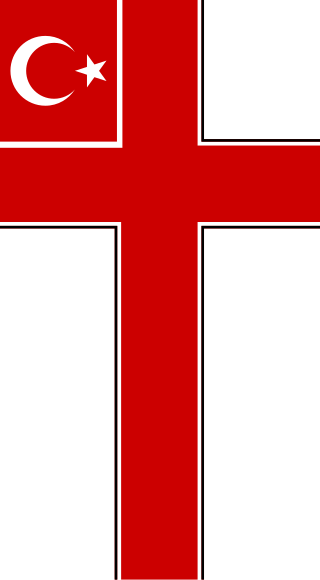
The Autocephalous Turkish Orthodox Patriarchate, also referred to as the Turkish Orthodox Church, is an unrecognized autocephalous Eastern Orthodox organisation based in Turkey, descending from Turkish-speaking Eastern Orthodox Christians. It was founded in Kayseri by Pavlos Karahisarithis, who became the patriarch and took the name of Papa Eftim I, in 1922.

The Halki seminary, formally the Theological School of Halki, was founded on 1 October 1844 on the island of Halki, the second-largest of the Princes' Islands in the Sea of Marmara. It was the main school of theology of the Eastern Orthodox Church's Ecumenical Patriarchate of Constantinople until the Turkish parliament enacted a law banning private higher education institutions in 1971. The theological school is located at the top of the island's Hill of Hope, on the site of the Byzantine-era Monastery of the Holy Trinity. The premises of the school continue to be maintained by the monastery and are used to host conferences. It is possible to visit the island where it is located via boat in approximately one hour from the shore of Istanbul. An international campaign to reopen this theological school is ongoing.

Gregory VII was Ecumenical Patriarch of Constantinople from 1923 until 1924. He was the Metropolitan of Chalcedon before being elevated to the patriarchal throne. He imported the New Style Calendar to the Church of Constantinople. He died suddenly of a massive heart attack in 1924.

The Greeks in Turkey constitute a small population of Greek and Greek-speaking Eastern Orthodox Christians who mostly live in Istanbul, as well as on the two islands of the western entrance to the Dardanelles: Imbros and Tenedos. Greeks are one of the four ethnic minorities officially recognized in Turkey by the 1923 Treaty of Lausanne, together with Jews, Armenians, and Bulgarians.

Kınalıada is the fourth smallest inhabited island in the Princes' Islands in the Sea of Marmara; near Istanbul, Turkey. It is also the closest of the islands to the mainland, lying about 12 kilometres (7 mi) to the south. Administratively, it is a neighbourhood in the municipality and district of Adalar, Istanbul Province, Turkey. Its population is 2,025 (2022). In the past it was called Proti by its Greek residents.

Christakis Zografos was an Ottoman Greek banker, benefactor and one of the distinguished personalities of the Greek community of Constantinople.

Eastern Orthodox Christianity is today the religion of only a minority in Turkey. It was once the dominant religion, during the time of the Byzantine Empire, as the region that comprises Turkey today was a central part of the Byzantine heritage. Today, less than one tenth of one percent of the population are Orthodox Christians. The provinces of Istanbul and Hatay, which includes Antakya, are the main centers of Christianity in Turkey, with comparatively dense Christian populations, though they are minorities in these areas. The traditional variant of Orthodox Christianity present in Turkey is the Eastern Orthodox branch, focused mainly in the Greek Orthodox Church.
Metropolitan Nicholas was metropolitan bishop of Amissos and Primate of the American Carpatho-Russian Orthodox Diocese of the US.

The Monastery of the Transfiguration, known locally as Hristo [Christ] Monastery, is a prominent Greek Orthodox monastery that has served the Greek Orthodox community of Constantinople since the time of the Byzantine Empire. The monastery is located on the island of Kınalıada, one of the Prince Islands in the Sea of Marmara. It is situated on one of the highest peaks on the island called Hristo Peak, which is named after the Monastery. The Monastery is especially known as a destination for exiled Byzantine Emperors in the 11th century.
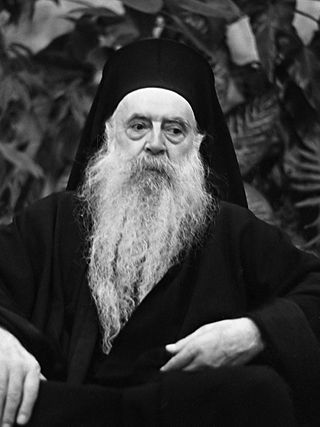
Athenagoras I, born Aristocles MatthaiouSpyrou, was Greek Orthodox Archbishop of North and South America from 1930 to 1948 and the 268th Ecumenical Patriarch of Constantinople from 1948 to 1972.
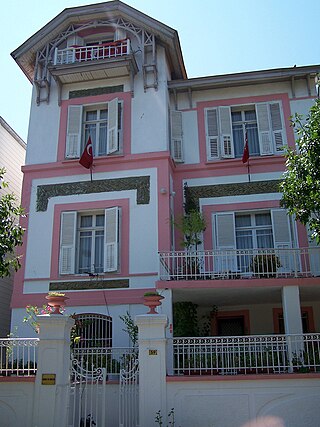
İsmet İnönü House Museum is a house museum in Istanbul, Turkey.
Değirmenburnu Nature Park is a nature park in Istanbul Province, Turkey.

The Halki Theological School Gardens are located in the top of the Hill of Hope in Heybeliada in Turkey. Halki seminary, also known as Halki theological school, was built in 1844 as the lighthouse of Ecumenical Patriarchate of Constantinople. Due to its closure in 1971, it the Byzantine Church of Holy Trinity is open to the public.
